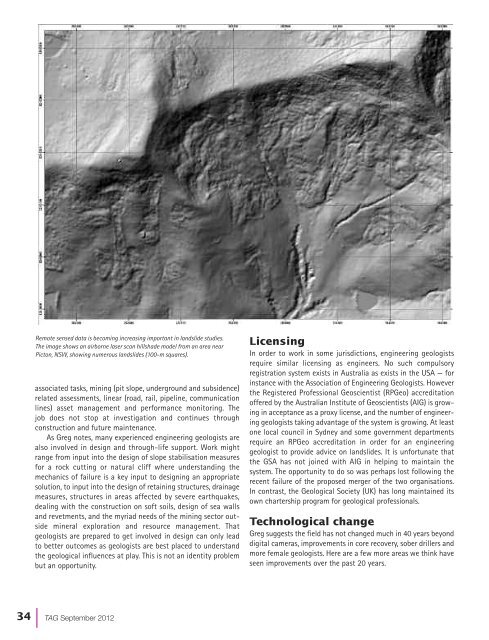Cross-section through the GreatEscarpment north <strong>of</strong> Wollongongthat illustrates the l<strong>and</strong>forms,geology <strong>and</strong> slope retreat rates(from Wilson et al, 2005).A detailed underst<strong>and</strong>ing<strong>of</strong> the coastal geology <strong>and</strong>geomorphology was critical in theconstruction <strong>of</strong> the Sea Cliff Bridgenorth <strong>of</strong> Wollongong.A smaller number <strong>of</strong> engineering geologists continue to workfor government authorities such as State government transportdepartments. However in our experience these positions arecontinuing their long-term decline as more <strong>of</strong> this work isoutsourced to private consultancies. The hollowing out <strong>of</strong>geological experience from government departments needed tooversee <strong>and</strong> appropriately manage such outsourcing is <strong>well</strong>beyond the scope <strong>of</strong> this article. It is an issue likely to be <strong>of</strong>concern in the near future if the trend continues.TeachingOne fundamental grass roots element <strong>of</strong> engineering geology —academic teaching — is on death row. Over the past decade therehas been a flood <strong>of</strong> overseas-trained engineering geologists to<strong>Australia</strong> (particularly from the UK <strong>and</strong> to a lesser extent fromNZ) to satisfy dem<strong>and</strong> in the industry that cannot be addressedlocally. Many <strong>of</strong> these geologists have undergraduate training inengineering geology <strong>and</strong> geotechnical engineering. This differsfrom our experience in <strong>Australia</strong>n universities where engineeringgeology hardly rated a mention, <strong>and</strong> was certainly never a coursecomponent.The presence <strong>of</strong> the discipline in universities in <strong>Australia</strong>, <strong>and</strong>in many other countries around the world, is essentially now nonexistent.Greg McNally’s own departure from the School <strong>of</strong>Applied Science at the University <strong>of</strong> New South Wales (UNSW)was a final sad blow (<strong>and</strong> he is sadly missed in that role, althoughfortunately not lost to the industry). The School <strong>of</strong>Civil Engineering at UNSW still <strong>of</strong>fers the popular Master <strong>of</strong>Engineering Science degree <strong>and</strong> is at least one small source <strong>of</strong>some engineering geology training, although most graduateswould come from the engineering side. The AGS runs ‘Geologyfor Engineers’ <strong>and</strong> ‘Engineering Geology’ continuing pr<strong>of</strong>essionaldevelopment (CPD) courses in alternating years. This stemmedfrom the pioneering work <strong>of</strong> David Stapledon, <strong>and</strong> was taken upby Alan Moon <strong>and</strong> Fred Baynes. It is now run by Fred Baynes,Mark Eggers <strong>and</strong> Phil Flentje. These eight-day field courses arealways fully subscribed <strong>well</strong> in advance. There are others inacademia who run other short courses here <strong>and</strong> there (<strong>and</strong> thereis not space here to list them all) although in general it is truethat the discipline does not have a place in <strong>Australia</strong>n academiatoday <strong>and</strong> this is a very sad state <strong>of</strong> affairs. There is a fledglinggroup developing a nebulous epistemic Engineering GeologyGroup that will work towards restoring this imbalance. Interestcould be directed towards Flentje.An identity problem?What does an engineeringgeologist do these days?The nature <strong>of</strong> the work is very broad, increasingly so, reflectingthe diversity <strong>of</strong> clients <strong>and</strong> broad nature <strong>of</strong> projects. Unlike otherapplied specialities <strong>of</strong> geology, engineering geologists can findthemselves working practically anywhere <strong>and</strong> therefore must beable to draw on their knowledge <strong>of</strong> all disciplines <strong>of</strong> geology.Engineering geology remains founded on building an underst<strong>and</strong>ing<strong>of</strong> the geology <strong>of</strong> a site, including its ancient <strong>and</strong> recenthistory, to build an awareness <strong>of</strong> the geological influences onproposed engineering works, <strong>and</strong> to clearly pass this informationon to geotechnical <strong>and</strong> civil engineers <strong>and</strong> others for use indetailed design. The multidisciplinary work can include geological<strong>and</strong> geomorphological mapping, management <strong>of</strong> geotechnicalinvestigations, engineering characterisation <strong>of</strong> rocks <strong>and</strong> soilslikely to be encountered, identification <strong>of</strong> any materialsdeleterious to the proposed work <strong>and</strong> how they should bemanaged (eg, acid rock <strong>and</strong> soils, or natural occurrences <strong>of</strong>asbestos), aquifer investigations <strong>and</strong> management, carbonsequestration, coal seam gas issues, assessment <strong>of</strong> potential slopestability issues <strong>and</strong> the means to address <strong>and</strong> or mitigate them,examining <strong>and</strong> assessing the hydrogeology <strong>of</strong> the site <strong>and</strong> itseffect on proposed development, undertaking informedinvestigations <strong>of</strong> the impact <strong>of</strong> climate variability <strong>and</strong> our myriad<strong>of</strong> terrains, l<strong>and</strong>slide risk management <strong>and</strong> the myriad <strong>of</strong>TAG September 2012| 33
Remote sensed data is becoming increasing important in l<strong>and</strong>slide studies.The image shows an airborne laser scan hillshade model from an area nearPicton, NSW, showing numerous l<strong>and</strong>slides (100-m squares).associated tasks, mining (pit slope, underground <strong>and</strong> subsidence)related assessments, linear (road, rail, pipeline, communicationlines) asset management <strong>and</strong> performance monitoring. Thejob does not stop at investigation <strong>and</strong> continues throughconstruction <strong>and</strong> future maintenance.As Greg notes, many experienced engineering geologists arealso involved in design <strong>and</strong> through-life support. Work mightrange from input into the design <strong>of</strong> slope stabilisation measuresfor a rock cutting or natural cliff where underst<strong>and</strong>ing themechanics <strong>of</strong> failure is a key input to designing an appropriatesolution, to input into the design <strong>of</strong> retaining structures, drainagemeasures, structures in areas affected by severe earthquakes,dealing with the construction on s<strong>of</strong>t soils, design <strong>of</strong> sea walls<strong>and</strong> revetments, <strong>and</strong> the myriad needs <strong>of</strong> the mining sector outsidemineral exploration <strong>and</strong> resource management. Thatgeologists are prepared to get involved in design can only leadto better outcomes as geologists are best placed to underst<strong>and</strong>the geological influences at play. This is not an identity problembut an opportunity.LicensingIn order to work in some jurisdictions, engineering geologistsrequire similar licensing as engineers. No such compulsoryregistration system exists in <strong>Australia</strong> as exists in the USA — forinstance with the Association <strong>of</strong> Engineering Geologists. Howeverthe Registered Pr<strong>of</strong>essional Geoscientist (RPGeo) accreditation<strong>of</strong>fered by the <strong>Australia</strong>n Institute <strong>of</strong> Geoscientists (AIG) is growingin acceptance as a proxy license, <strong>and</strong> the number <strong>of</strong> engineeringgeologists taking advantage <strong>of</strong> the system is growing. At leastone local council in Sydney <strong>and</strong> some government departmentsrequire an RPGeo accreditation in order for an engineeringgeologist to provide advice on l<strong>and</strong>slides. It is unfortunate thatthe GSA has not joined with AIG in helping to maintain thesystem. The opportunity to do so was perhaps lost following therecent failure <strong>of</strong> the proposed merger <strong>of</strong> the two organisations.In contrast, the <strong>Geological</strong> <strong>Society</strong> (UK) has long maintained itsown chartership program for geological pr<strong>of</strong>essionals.Technological changeGreg suggests the field has not changed much in 40 years beyonddigital cameras, improvements in core recovery, sober drillers <strong>and</strong>more female geologists. Here are a few more areas we think haveseen improvements over the past 20 years.34 |TAG September 2012
















